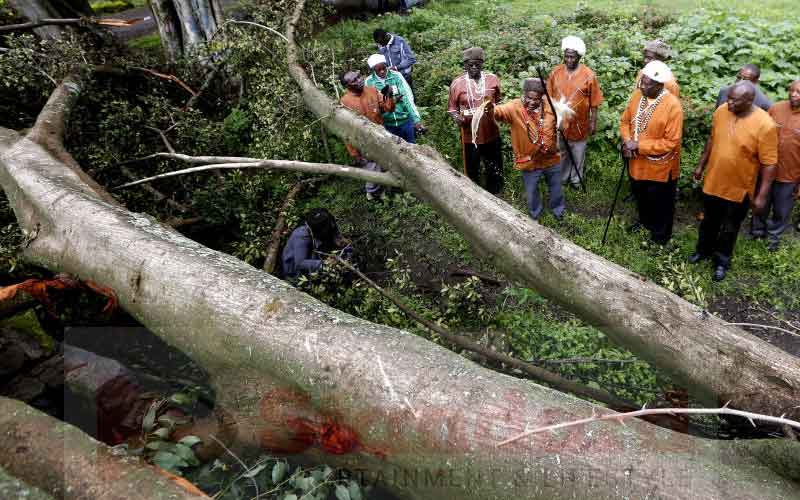
The Mugumo tree holds profound cultural and spiritual significance as a sacred symbol within the Kikuyu community of Kenya. Revered as a living connection to their ancestors and the spiritual realm, the Mugumo tree plays a central role in various ceremonies, rituals, and beliefs that underscore the community’s deep-rooted cultural heritage. Its presence in the landscape not only symbolizes continuity and resilience but also serves as a tangible representation of the community’s collective identity and spiritual practices, making it a revered cultural icon among the Kikuyu people.
Cultural Significance and Mythology
The Mugumo tree, scientifically known as Ficus thonningii, is revered for its historical and mythological significance in Kikuyu culture. According to tradition, the Mugumo tree is believed to be a dwelling place for ancestral spirits and divine beings. It is considered a mediator between the living and the spiritual world, where prayers and offerings are made to seek blessings, protection, and guidance from ancestors. The tree’s longevity and robustness symbolize endurance, wisdom, and the continuity of ancestral lineage, fostering a deep sense of connection to the community’s roots and heritage.
Rituals and Ceremonies
Various rituals and ceremonies center around the Mugumo tree, reflecting its sacred status within Kikuyu culture. One such ritual is the offering of sacrifices and libations during important milestones such as births, weddings, and funerals. These ceremonies honor ancestral spirits and seek their blessings for prosperity, fertility, and protection. Elders conduct prayers and traditional rites under the shade of the Mugumo tree, invoking its spiritual presence and channeling divine energies believed to reside within its branches and roots. Such rituals reinforce communal bonds, preserve cultural traditions, and transmit ancestral knowledge across generations.
Ecological Importance and Conservation Efforts
Beyond its cultural significance, the Mugumo tree plays a vital ecological role in Kenya’s landscape. As a native species, it supports biodiversity by providing habitat and sustenance for various flora and fauna. Its dense foliage offers shade and shelter to wildlife, while its fruits serve as a food source for birds and small mammals. In recent years, conservation efforts have focused on preserving and safeguarding the Mugumo tree from deforestation, urbanization, and climate change impacts. Community-led initiatives promote sustainable land management practices that protect the tree’s natural habitats and ensure its continued presence for future generations.
Symbolism of Unity and Community Identity
The Mugumo tree embodies principles of unity and community identity among the Kikuyu people. Its towering presence in communal spaces symbolizes strength, solidarity, and mutual respect within the community. Traditional gatherings, storytelling sessions, and cultural celebrations often take place under the shade of the Mugumo tree, fostering a sense of belonging and shared cultural heritage. Through collective rituals and social interactions, the tree serves as a focal point for transmitting oral histories, cultural values, and ethical teachings that shape the community’s moral fabric and social cohesion.
Spiritual Practices and Beliefs
Spiritual practices associated with the Mugumo tree reflect the Kikuyu people’s belief in ancestral veneration and divine intervention. Elders and spiritual leaders perform sacred rites and ceremonies under the tree’s canopy, invoking ancestral spirits to intercede on behalf of the community. Offerings of food, milk, and traditional brews are presented as tokens of gratitude and supplication, reinforcing spiritual connections and divine blessings. The tree’s spiritual significance underscores the Kikuyu worldview of harmony with nature, reverence for ancestral wisdom, and the interconnectedness of all living beings within the cosmic order.
Cultural Heritage and Oral Traditions
The Mugumo tree features prominently in Kikuyu oral traditions, folklore, and legends passed down through generations. Mythical narratives recount tales of heroic deeds, supernatural encounters, and moral lessons associated with sacred trees like the Mugumo. These stories preserve cultural memory, celebrate ancestral achievements, and impart moral teachings that guide ethical conduct and communal harmony. By safeguarding oral traditions and cultural heritage, the Mugumo tree continues to inspire pride, resilience, and cultural pride among the Kikuyu people, reinforcing their unique identity and spiritual connection to the land.
Contemporary Significance and Challenges
In contemporary times, the Mugumo tree faces challenges from urbanization, agricultural expansion, and climate change, threatening its survival and cultural significance. Efforts to conserve and protect sacred groves and individual trees are underway, supported by community engagement, environmental education, and advocacy for sustainable land use practices. These initiatives aim to balance conservation goals with socio-economic development, ensuring that future generations can continue to benefit from the spiritual, ecological, and cultural values embodied by the Mugumo tree. Embracing traditional ecological knowledge and modern conservation strategies can help safeguard this iconic symbol of Kikuyu cultural heritage for posterity.
Summary
The Mugumo tree stands as a revered symbol of cultural resilience, spiritual interconnectedness, and ecological stewardship within the Kikuyu community. Its profound significance in rituals, mythology, and communal life underscores its role as a living testament to the community’s ancestral wisdom, unity, and cultural identity. By preserving and honoring the Mugumo tree, the Kikuyu people uphold centuries-old traditions, nurture ecological diversity, and affirm their commitment to sustainable development and cultural continuity. As guardians of this sacred heritage, they ensure that the Mugumo tree remains a cherished emblem of cultural pride, spiritual vitality, and environmental stewardship for generations to come.